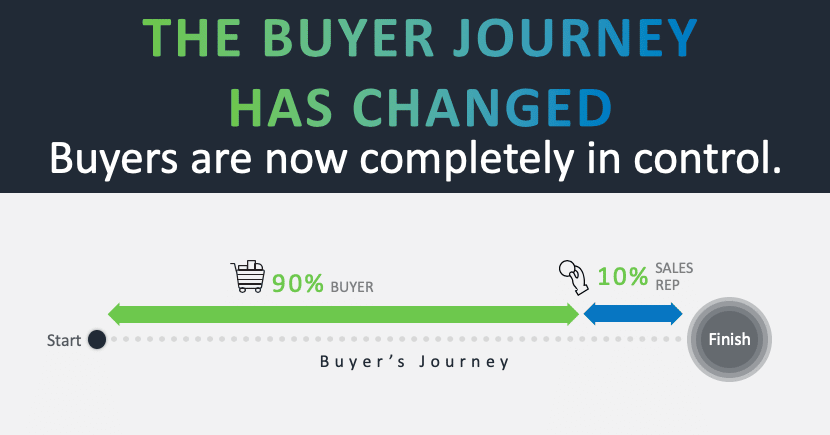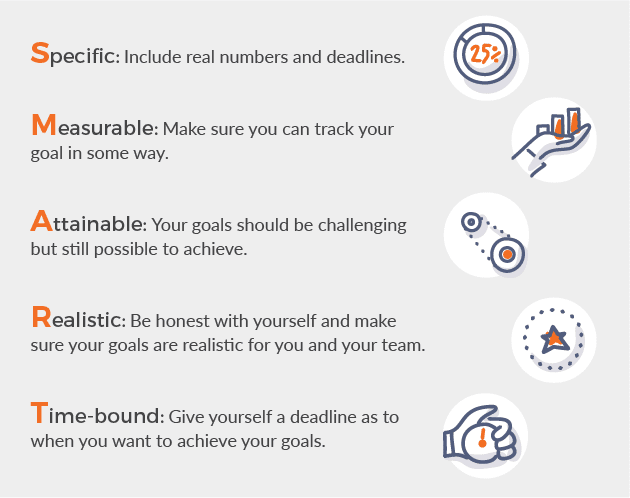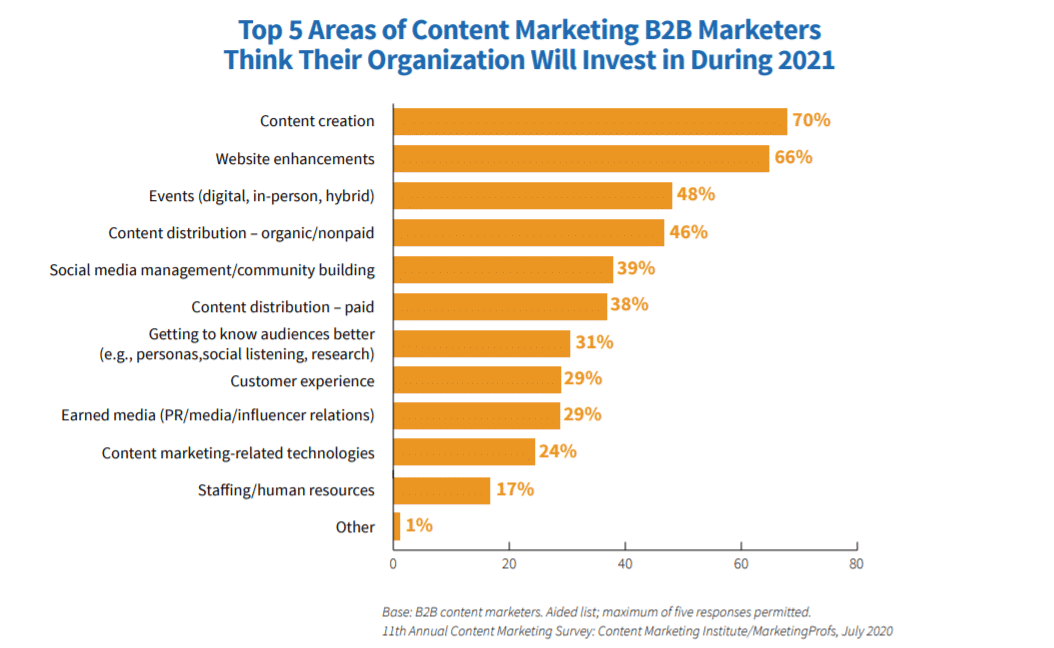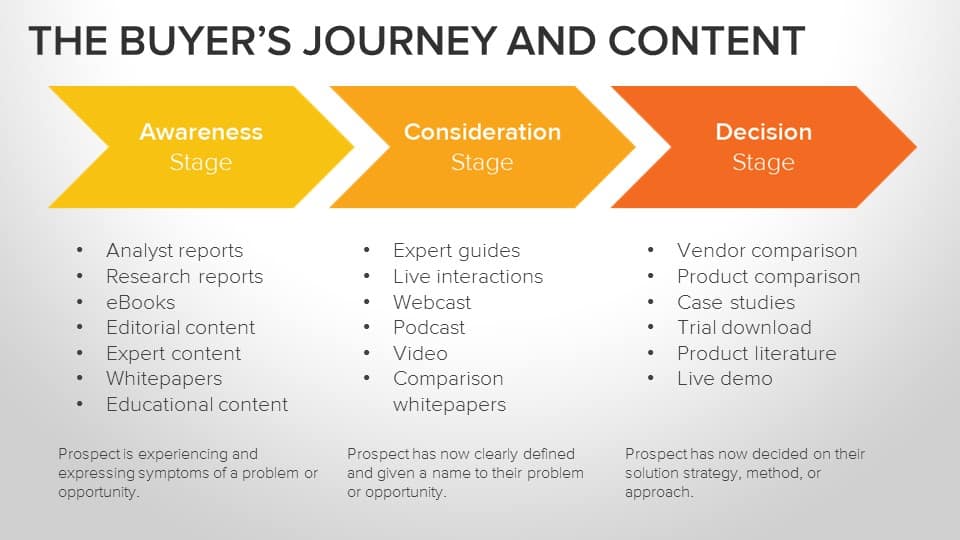
What’s Your B2B Sales Enablement Content Strategy?
In today’s B2B sales world, buyers are in charge. The digital era has created a sales landscape where customers are self-educating for months or even years before they indicate interest in a purchase.
For brands, this means finding a way to build a relationship with their target audience before ever interacting with them directly, and for B2B brands especially, it means doing so in a way that maintains the level of thought leadership and expertise that B2B buyers expect.
How do they do this? Content marketing.
But content is not enough on its own. Brands must first consider who their target audience is, which content and channels will be most effective at reaching them, and how they’ll measure ROI. Otherwise, they risk producing content that eats up resources without achieving results.
In other words? B2B brands don’t just need content, they need a content marketing strategy — one that considers the specific nuances of B2B selling and the buyer journey.
Quick Takeaways:
- Customers own the buying process – 90% of the journey is conducted by the buyer without assistance from a sales representative.
- Content is the currency by which B2B brands are earning buyer attention. Content builds relationships with prospective buyers in the early stages of their journey.
- Content strategies give content a purpose; when developing a content strategy, B2B brands should set measurable goals with defined metrics that help them assess ROI.
- B2B content strategies have both internal and external purposes – the former to support the sales team, and the latter to build buyer trust and convert sales.
A Shift in the B2B Customer Journey
Customers no longer depend on brands for basic information about a product, and by the time they reach out for an initial conversation they’re often experts in their own right on the features and benefits offered by a brand solution.
As a result, the B2B sales pitch has shifted away from focus on the product and instead requires showing an understanding of the buyer’s need (the problem they’re trying to solve) and a personalized pitch that demonstrates how the product can provide the right solution (and do it better than its competitors, who the buyer will also know about already).

There are two key takeaways here. First, brands need to create effective content for buyers to interact with during the first stages of their buying process. This helps establish a brand as an industry leader and creates recognition so that a customer remembers them when it’s time to make a purchase.
Second, the content developed for sales teams to use during the later stages of the buying process must position the features and benefits of a product in ways that demonstrate how they address customer needs and solve their problems.
Why Content is King for B2B Sales
Content is the currency by which brands are earning buyer attention. Content is also what gives brands the ability to build a relationship with potential customers despite the shift toward a more autonomous buyer journey. This relationship building is more important than ever as B2B buyers become less dependent on brands to help them build an understanding of a product or industry and thus less worried about brand loyalty later on.
Instead, B2B buyers, on behalf of their companies, want an experience more like the one they seek in their individual B2C consumer lives — one that connects emotionally (yes, even in B2B sales) with their needs and feels personalized to their company.
“We have a bit of a formula for B2B empathy. It starts with deep customer knowledge (both quantitative and qualitative), truly understanding the needs, wants, and feelings behind that customer’s journey and their purchase, and it ends in content that is genuinely helpful, that imparts insights, that helps before that customer buys anything from you and embraces the emotion of what they’re looking for, the outcomes that they’re looking for as a person. And it is humanized in the buyer journey that exists for that actual customer.”
- April Henderson, Vice President, Practice Director, Market Impact Consulting at Forrester Research
Creating Your Sales Enablement Content Strategy
Creating a B2B sales content strategy means the difference between putting your content out there and hoping it will stick and producing content with intent, goals, and audience in mind.
The latter is necessary to see ROI from your content over time, and while content strategy won’t look the same for any two brands, there are best-practice steps every company should take to develop a content strategy that’s most effective.
Set SMART Goals
Content strategy goals should always be defined. Setting SMART goals that not only decide what you want to accomplish but set parameters around how and when you will measure success creates a common sense of direction and promotes accountability for your teams.

Know Your Buyer Personas
Understanding your target audience is critical to a successful B2B content strategy and buyer personas are a powerful tool for getting to know your customers. It’s important to create personas that are actionable, evidence-based, and aligned with the target audience your brand wants to attract.
When creating your personas, don’t focus on an arbitrary idea of who your customer is (this can pigeonhole you unintentionally) — instead, focus on what your customer is trying to achieve and how your solution can help them do it.
Know What You Need to Deliver
We’ve said content strategy is about decisions and prioritization. A good starting point is to identify key customer touch points and conversations. Examples include prospecting, early meetings, qualifying, value, your insights and key points, and negotiating conversations.
Look for where content can provide:
- Analysis and discovery support (analysis questions are a critical content category that marketing regularly neglects and sales often doesn’t document)
- Visual Support for key conversations (as well as formal presentations)
- Support for 3rd party delivery: audio/video guidance; education about problems and solution approaches
- Answers to buyer questions, technical explanations, important and difficult to explain concepts
- Proof: Focused on specific elements within the A and B categories; analyst research and perspectives, customer explanations, facts, problem-cost calculators,
- Stories — focused directly on specific elements within A, B and C categories
There are many ways to package and deliver content. The best way will depend on each engagement and conversation scenario. Sales people, and others familiar with each customer engagement, are often best to make this determination.
The traditional content process has content creators pre-package content as a finished asset. To optimize content relevance and situational effectiveness, leading organizations shift final content assembly to just before delivery.
A supporting trend is to deploy modular content assets. This should be content that can be edited, personalized, configured and packaged for each “downstream” tactical activity. Examples include prospecting and lead generation, social media, and specific direct and channel sales scenarios.
Creating content as modular, editable and configurable components for sales people to package as finished content that is relevant to audiences, and suitable for sales purposes, should be a key consideration of sales content strategy.
To support this objective we recommend deploying inventories of smaller content “assets,” such as:
- Conversation starters and guides
- Emails
- Social posts: Twitter, LinkedIn, Google+, other relevant channels
- Buyer questions and answers to buyer questions (objections) with support and proof: facts, research, stories
- Diagnostic analysis and other questions to ask buyers
- A high level, over-arching point-of-view, and accompanying storyline
- Key Points for educating buyers — Unique insights
- Key Messages – Differentiated value points
- Facts and Research Results, Quotations
- Stories and Examples: Problem related stories, Customer Stories, Key point stories
- Language inventory – Topics, themes, words and phrases to use and avoid
- Links to related, supporting content
- All tested for resonance with buyers
Create Processes to Stay on Track
Creating internal processes for the delegation of content responsibilities like development, delivery, and approval are essential to your content strategy. Without processes, content can get pushed aside or lost in the mix of your team’s other areas of focus.
To get the most out of your content strategy, make it a priority. Even if you don’t have a dedicated content team (the ideal scenario) make sure you’re clearly outlining who is responsible for what and use a content calendar to stay on track with delivery and publishing of your content.
Your marketing department should (ideally already):
- Develop a foundational, Business Level Content Strategy based on sound frameworks, expert facilitation, input and validation from the right resources. For guidance on this work, which must be completed for an effective sales content strategy.
- This should yield a deep understanding of buyers, how they see (or should see) their problems, the cost of those problems; how they see their options (and hear from your competitors); as well as their buying decision process. Details of this are explained below.
- Based on this understanding, develop the foundational language, stories and other elements required for effective messages and conversations.
- Design key sales conversations. This will yield insights for specific conversation support content: emails, voicemails, linked content, visual support, facts and research, stories and proof points.
- Define your content use case requirements for key buyer touch points and sales engagement conversations. Consider the methods of engagement and delivery (channels); the nature of the conversations at each touch point and the content support they require; the information and decisions buyers are making at each buying stage; key relevance factors: buyer persona or role, industry vertical.
- Document content specifications to guide non-sales oriented content creators to develop the final deliverable with the right inputs.Think of this in a manner similar to defining product feature specifications for product engineers or software developers to execute. See our simplified “Content Header” as an example. Our complete Content Requirements Documents typically go to several pages.
- Prioritize content required for key conversations and touch points; assess existing content inventory; identify gaps; define core content and expected highly used content.
- Decide what to create, why, how, how much to invest.
Know How You’ll Measure Success
While 72% of B2B brands consider content a core business strategy and 70% place it in their top five areas of investment in 2021, only 21% feel that they are any good at measuring the actual ROI of their content — the entire reason for its existence!

The difficulty of measuring ROI often comes from lack of clarity around metrics, which is why including metrics as part of your goal setting is essential. When you do, your team is aware of the process and doesn’t feel overwhelmed at the prospect of trying to measure ROI without knowing where to start.
The Sales and Marketing Disconnect
A challenge particularly common for B2B brands is the disconnect between sales and marketing teams. While both are focused on increasing sales, marketing teams often create content with mass dissemination in mind. They may not think or have knowledge of the many nuanced aspects of the sales pitch or a real understanding of what sales teams are “hiring” content to do at various points in the process.
B2B sales requires an entire arsenal of content that doesn’t just live on the web in the form of blog posts — sales teams need sophisticated content like white papers, vendor comparisons, research reports, and more. If your content creators don’t have a real understanding of the right messaging and approach these materials should take, your sales team will be left to fill those gaps. Even worse, they may end up spending time trying to create or edit content themselves instead of keeping a laser focus on making sales.

Whether your brand has an in-house marketing team or content agency developing your content, it’s important to create open lines of communication and a culture of collaboration between your content creators and your sales teams. Content is no longer “marketing’s responsibility” and to make it most effective, everyone who uses it needs to feel empowered to contribute to its quality.
The B2B Sales Content Your Company Needs
B2B sales companies need content that supports two primary purposes: building a relationship with potential buyers and supporting sales teams so that they can execute the sale. Brands can consider these two purposes as falling under internal (content that supports sales teams) and external (content that builds relationships with customers).
Internal content includes things like sales playbooks, training guides, skills development resources, and competitor information.
External content includes anything buyers will see: stories and articles, presentations, case studies, research reports, white papers, videos, podcasts, demos — you name it.
Creating a content strategy helps you identify what the overarching purpose of your content will be in the sales process and thus help you decide which content to create, how to create it, and where it will be used in your brand’s sales process.
Marketing and sales teams should work together during the content strategy development process to identify key touchpoints between buyer and content (early in the process) as well as buyer and sales team (later on). This ensures content is created to align specifically with the phase of the buyer journey and the channel of communication.
The best case scenario for B2B sales content strategy is an ongoing collaboration between the two teams that continually assesses new insights and trends and works together to apply them to the content strategy.
Sales Enablement: The Outcome of Your Content Strategy
Working from the end state, back through to the strategy process, the outcome of sales content strategy is to decide:
- The overall strategy for content to support sales functions and audiences
- What content to create — and not to create
- How to create content
- How much to invest
- How to execute sales content strategy — process and accountability
- Metrics — how to measure and report
Get Real About New Realities
Content plays a much more important role for selling in this digital era than ever before. Many sales leaders never experienced the new realities and new requirements of using content to sell in these ways. This has lowered their urgency and advocacy for better sales content.
Sales content is no longer “marketing’s responsibility.” Lagging sales organizations are missing a strategic asset that significantly impacts new customer acquisition, revenue growth, and lower selling costs through improved sales productivity and efficiency.
If you’re ready to get started on building a content strategy for your brand, check out our Content Builder Services or get in touch to learn how we can help!







